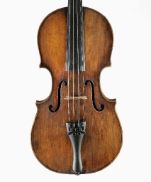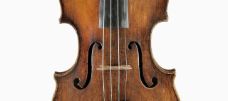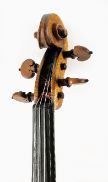Violin, Gaspare Lorenzini, Piacenza, around 1760
Handwritten label: “Gaspare Lorenzini GLP [in a heart-shaped cartouche] / fecit Placentiæ 1758”The violin model is very long and broad with an individual aspect. The divided belly made of spruce is fine-grained in the middle, with the annual rings widening toward the flanks. The wood of the two halves of the belly is a close match and is likely to have been taken from the same log. The one-piece, quarter-cut back is made of unflamed maple. The structure of the rib wood and the wood of the pegbox and scroll is similar to that of the back. The f-holes are reminiscent of Stradivari’s work, but unlike on instruments by Stradivari, the upper wings are nearly the same size as the lower wings. Thus, the f-holes look more massive and less elegant. The purfling and fluting are very close to the edge, letting the edges appear delicate, especially on the back. The volutes of the scroll are regular and harmonious. Conspicuous toolmarks are visible, as are layout puncture marks around the eyes (which are also typical of Guadagnini’s scrolls). Lorenzini used a golden-yellow ground on which an attractive, light brown color varnish can still be seen, above all in the fluting of the back plate.






